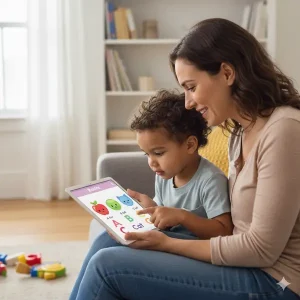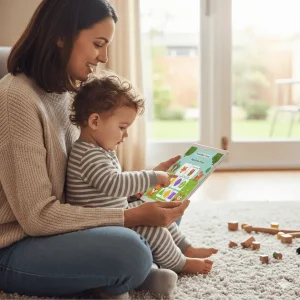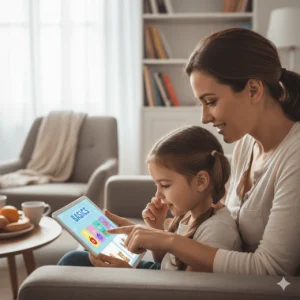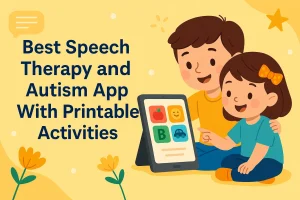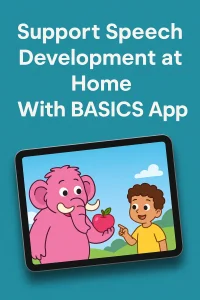How the BASICS App Builds Social and Emotional Skills
By Wellness Hub
Last Updated: October 15, 2025
Social and emotional development in children forms the foundation for how they connect, communicate, and handle their feelings. During early childhood, kids learn empathy, sharing, patience, and emotional awareness — skills that shape their future relationships and behavior. Yet, many parents find it challenging to teach these concepts in everyday life.
The BASICS App, designed by therapists, transforms emotional learning into interactive play. Through visual stories, conversation-based games, and gentle guidance, it helps children recognize feelings, express emotions, and build social confidence. This play-based approach makes social and emotional learning engaging, consistent, and effective — right from home, one joyful interaction at a time.
Understanding Social and Emotional Development in Early Childhood
What Are Social and Emotional Skills?
Social and emotional skills are the foundation of how children understand themselves and relate to others. These include the ability to identify feelings, manage emotions, build relationships, take turns, and show empathy. In early childhood, these abilities begin to form through daily experiences—like sharing toys, comforting a friend, or expressing happiness after completing a task.
Developing these skills helps children communicate their needs, handle frustration, and cooperate with peers. Emotional understanding also supports problem-solving, attention, and early learning. When children can recognize how they feel and respond appropriately, they build a stronger sense of confidence and security in their environment.
Why Early Emotional Learning Matters for Communication and Relationships
Early emotional learning shapes the way children communicate and connect with others. A child who can recognize their own feelings and read the emotions of others is more likely to express themselves clearly, listen effectively, and build positive relationships.
These early lessons in emotional understanding support the development of language. When children learn words like happy, angry, or sad, they begin to label their experiences instead of reacting impulsively. This ability to name emotions improves self-regulation and lays the groundwork for healthy communication patterns later in life.
Emotionally aware children are also more adaptable in group settings. They can follow directions, wait patiently, and understand others’ perspectives—key skills for both school readiness and social success.
The Link Between Play, Empathy, and Self-Awareness
Play is the most natural way young children learn social and emotional skills. Through pretend play, storytelling, and turn-taking games, children explore emotions in a safe and imaginative space. For example, when a child pretends to care for a toy or role-plays as a doctor, they begin to understand empathy and responsibility.
Interactive play also builds self-awareness. Children learn to recognize their strengths, handle mistakes, and express preferences—all while developing emotional resilience. Guided play, where adults join and model responses (“You look sad—what can we do to feel better?”), deepens this understanding even further.
When play becomes purposeful—such as through story-based learning or emotional games—it nurtures empathy and teaches children how emotions guide actions. Over time, this connection between play, empathy, and self-awareness helps children form strong emotional foundations that support communication, friendship, and lifelong learning.
Also read: How BASICS App Builds Early Learning Foundations Through Play
Challenges Parents Face in Teaching Emotional Skills
Helping children understand emotions can be one of the most rewarding yet challenging parts of early parenting. While young kids experience a wide range of feelings every day, recognizing and expressing those emotions in words takes time, guidance, and repeated exposure. Many parents find that emotional learning doesn’t happen automatically—it needs to be modeled, practiced, and supported through consistent interaction.
Why Emotions Are Hard for Young Children to Identify or Express
Children between ages 2 and 6 are still learning how to connect what they feel with what they see and say. Their brains are developing the ability to recognize facial expressions, interpret body language, and link those cues to words like “happy,” “angry,” or “scared.” Because emotional awareness is abstract, young children often rely on physical reactions—crying, shouting, or clinging—rather than language to show what they feel.
They may know something feels “bad” or “good” but lack the vocabulary to explain why. Without structured support, these early emotions can seem confusing, leading to frustration or withdrawal when they can’t communicate what’s happening inside.
Common Struggles: Tantrums, Frustration, or Limited Emotional Vocabulary
Many everyday behaviors—tantrums, meltdowns, or mood swings—stem from a child’s limited ability to express emotions effectively. A child who doesn’t yet understand what “angry” or “disappointed” means may react physically instead of verbally.
Parents often see this during transitions (“I don’t want to stop playing!”), when routines change, or when kids face challenges like sharing or waiting their turn. Without clear emotional vocabulary, children struggle to regulate themselves. This can make home routines, social interactions, and even early classroom experiences more stressful for both children and parents.
How Structured Emotional Play Can Simplify Learning
Structured emotional play—where feelings are introduced through guided visuals, stories, and interactive games—makes emotional learning easier and more natural. Rather than relying on lectures or correction, play helps children see and practice emotions in a safe, enjoyable way.
For instance, when a game asks a child to tap the “happy face” or match pictures showing different moods, they begin connecting facial expressions to specific words. Repeated exposure through story-based activities helps normalize emotions like sadness or anger, showing that all feelings are valid and manageable.
Apps like BASICS App use these therapist-designed techniques to teach emotional recognition step-by-step—turning challenging moments into opportunities for learning and self-expression. Over time, this kind of structured emotional play helps children replace frustration with words, empathy, and understanding.
The BASICS App Approach to Emotional Learning
Emotional learning begins with understanding, and the BASICS App builds this foundation through a carefully structured, therapist-designed approach. Each activity is created to help young children recognize, express, and manage their emotions—skills that shape their social interactions and long-term emotional health.
Designed by Therapists for Early Childhood Emotional Growth
Every element in BASICS is backed by developmental research and clinical experience. Speech and occupational therapists collaborated to create activities that meet children where they are—through play. The app introduces emotional concepts gradually, using facial expressions, voice tones, and relatable everyday scenes. This ensures that even very young learners, including children with speech delays or limited language, can begin to recognize and respond to emotions naturally.
Combining Speech, Visuals, and Real-Life Scenarios
BASICS blends visual learning (faces, colors, expressions) with verbal prompts and context-based play. Children see an emotion, hear its name, and connect it to a real-world situation—like being happy while playing or feeling sad when a toy breaks. This multi-sensory learning process helps emotions become meaningful and memorable, turning abstract feelings into experiences children can recognize in themselves and others.
The Importance of Consistent Reinforcement Through Play
In early childhood, repetition is key. BASICS reinforces emotional vocabulary through consistent practice rather than one-time exposure. By revisiting familiar emotional themes in different contexts—across games, conversations, and stories—children strengthen their understanding and retention. The app’s reward system encourages repeated play, helping emotional learning become part of everyday communication and behavior.
Emotions Explorer – Naming and Recognizing Feelings
The Emotions Explorer feature helps children take their first step in emotional awareness: naming what they feel. Using expressive visuals, clear narration, and interactive choices, this activity teaches children to identify emotions like happy, sad, angry, and scared in themselves and others.
Identifying Emotions Like Happy, Sad, Angry, Scared
Children match faces and expressions with corresponding emotions, helping them decode visual cues. This builds both self-recognition and empathy—understanding that others feel different things, too. By seeing multiple examples of the same emotion, kids learn that feelings can look slightly different but share a core meaning.
Visual Storytelling for Understanding Emotional Expressions
Each emotion is linked to a short story or real-life event. For instance, a child might see a picture of a broken toy with a sad face or friends playing together with smiles. These visual stories help children connect emotions with daily experiences, deepening comprehension beyond labeling.
How Repetition Builds Emotional Vocabulary
Repetition is built into the design. Children revisit feelings across different levels, gradually expanding from basic emotions (happy/sad) to more complex ones (surprised, shy, frustrated). This repetition—combined with engaging visuals and voice feedback—strengthens emotional vocabulary and confidence in expression.
Conversation Circles – Practicing Empathy and Turn-Taking
Conversation Circles turn emotional learning into interactive dialogue. Through question-and-response games, children learn how to listen, wait, share, and respond politely—skills that form the basis of empathy and cooperation.
Interactive Dialogues Teaching Listening, Waiting, and Sharing
Children are guided through simple conversations, such as taking turns talking about favorite activities or responding to friendly greetings. The activity encourages waiting for a response, showing interest, and staying engaged—core habits of social communication.
Building Polite Communication (“Thank You,” “Sorry,” “Please”)
Every session includes polite phrases that children can use in daily life. Practicing “thank you,” “sorry,” and “please” within the app helps normalize positive interactions and respectful communication. These phrases are linked with cheerful visuals and affirming feedback, making manners fun to learn.
Encouraging Confidence Through Conversational Play
Because Conversation Circles present communication as a game, children feel motivated to participate. Positive reinforcement helps even shy or hesitant kids find their voice. Over time, they begin to apply these skills at home, in classrooms, and during peer interactions—building confidence in expressing themselves clearly and kindly.
Social Stories – Learning Through Real-Life Scenarios
The Social Stories feature brings emotional understanding into real-world contexts. These short, illustrated scenarios guide children through common situations where emotions, patience, and problem-solving are needed.
How Story-Based Learning Teaches Friendship, Cooperation, and Calm-Down Routines
Children learn by watching familiar scenes unfold—like sharing toys, waiting in line, or helping a friend in need. Each story models positive social behavior, showing children that emotions can be managed and expressed constructively. This helps them understand what to do when feelings arise in similar real-life moments.
Modeling Appropriate Responses to Emotions and Social Cues
Through guided storytelling, BASICS shows both the challenge and the solution. For example, a child might feel angry when losing a game, but the story models deep breathing or asking for another turn. By observing and practicing these responses, children begin to internalize healthy coping strategies and emotional control.
Examples: “Waiting for Your Turn,” “Apologizing,” “Helping a Friend”
Stories such as “Waiting for Your Turn,” “Apologizing,” and “Helping a Friend” turn abstract social values into concrete experiences. These relatable examples teach patience, responsibility, and kindness—core elements of emotional intelligence. Over time, repeated exposure helps children generalize these behaviors beyond the app, improving their interactions in school and at home.
How Play Builds Emotional Regulation
The Neuroscience of Play-Based Emotional Learning
Play is one of the most natural ways for young children to learn how to manage emotions. When children play, their brains actively form new neural connections between the emotional centers (like the amygdala) and thinking areas (such as the prefrontal cortex). This connection helps them recognize feelings, control impulses, and make thoughtful decisions instead of reacting instantly.
Through repeated, playful experiences, children learn to associate emotions with context — joy when sharing, frustration when waiting, pride when achieving. Play-based learning allows them to practice these responses safely, so emotional control becomes a natural habit rather than a forced rule. In BASICS, each game is designed to activate these same neural pathways, helping children build self-regulation through curiosity and repetition rather than instruction.
Why Visual Feedback and Rewards Motivate Children
For young children, motivation is deeply linked to feedback. Visual cues — like stars, smiles, or animated rewards — give instant acknowledgment of effort and success. This positive reinforcement triggers dopamine release, which strengthens the brain’s learning loop and makes children more eager to repeat the task.
In BASICS, every tap, choice, and correct answer is met with a friendly animation or sound, signaling accomplishment. This system helps children understand that their actions have outcomes, building not only confidence but also patience and persistence. Over time, these small emotional “wins” reinforce self-control, turn-taking, and resilience — all essential components of emotional regulation.
How BASICS App Uses Gentle Correction and Encouragement to Guide Behavior
Unlike traditional instruction, BASICS uses gentle cues to redirect rather than punish mistakes. When a child selects the wrong answer, the app provides supportive feedback — a soft sound, a visual hint, or a verbal prompt — encouraging them to try again. This approach reduces frustration and teaches that errors are part of learning, not failure.
The tone of BASICS remains calm and positive throughout, mirroring the kind of emotional environment therapists create during real sessions. Each success is acknowledged with warmth and encouragement, fostering an inner sense of pride and self-regulation.
By pairing emotional safety with interactive play, BASICS helps children learn that staying calm and trying again leads to success — a powerful lesson that extends beyond the screen into daily life.
Integrating BASICS App Into Daily Routines
Building emotional and social skills works best when it becomes part of a child’s everyday life — not a one-time lesson. The BASICS App is designed to blend seamlessly into your child’s daily routines, turning ordinary moments into powerful learning opportunities. Here’s how parents can make emotional learning a natural part of the day.
Practical Tips for Parents: When and How to Use BASICS App
Start by setting a consistent time for BASICS play — ideally when your child is calm and focused. Morning or early evening sessions (10–15 minutes) work best. Consistency helps children anticipate learning as part of their schedule, just like brushing teeth or bedtime reading.
Let your child explore one goal at a time instead of switching between activities too often. For instance, if you’re working on Emotions Explorer, spend a few days practicing feelings like happy or sad through app visuals and repeat them in daily conversations.
Use the Goal Mode for structured practice and the Library Mode for free exploration. Goal Mode ensures your child completes a guided path, while Library Mode allows repetition of favorite activities — a great balance for both focus and motivation.
Keep sessions short, engaging, and pressure-free. The goal is to create curiosity and connection, not perfection. If your child loses interest, pause and revisit later — children learn best when they’re emotionally ready.
Creating Consistent Emotional Learning Moments at Home
The BASICS App works best when paired with real experiences. After finishing an activity, encourage your child to name feelings in daily life — “You look happy while playing,” or “I see you’re upset that the toy broke.”
These small acknowledgments reinforce emotional vocabulary outside the screen.
Use routine cues to connect app learning to everyday tasks:
- Morning: Practice emotions during dressing or breakfast (“Which emoji shows how you feel today?”)
- Afternoon: Use BASICS after playtime to discuss sharing, turn-taking, or problem-solving.
- Evening: Reflect together — “What made you happy today?” — just like the app’s reflection games.
Over time, this routine turns BASICS from a digital tool into a habit of emotional awareness, helping your child identify, express, and manage feelings independently.
Pairing App Activities With Real-Life Interactions
Each BASICS activity mirrors real-life situations that parents can easily build upon:
- Emotions Explorer → Storytime: After identifying “happy” and “sad” faces in the app, read storybooks and pause to ask, “How do you think this character feels?”
- Conversation Circles → Playdates: Before meeting friends, practice polite exchanges through the app (“Hi,” “Can I play?”), then encourage your child to use them in real interactions.
- Social Stories → Meals or Routines: When the app shows “Waiting for your turn” or “Helping others,” apply it during mealtimes or chores — “Let’s wait while I serve food,” or “Can you help set the table?”
These bridges between digital and real life make learning meaningful and lasting. The goal is for children to see that emotions, kindness, and patience aren’t just part of the app — they’re part of daily living.
Emotional Growth Beyond the Screen
Digital learning is most powerful when it translates into real-world behavior—and that’s exactly what the BASICS App is designed to do. The emotional lessons children learn while playing—recognizing feelings, waiting for their turn, or calming down after frustration—begin to show up naturally in daily life.
How children generalize emotional skills from app to real life
When children interact with the Emotions Explorer or Conversation Circles, they don’t just memorize labels like happy or sad—they learn what those feelings look like and how to respond. Over time, these visual and auditory cues help them identify emotions in real people and situations. A child who practices saying, “I’m angry” in the app may later use that same phrase during playtime instead of crying or hitting.
Consistent exposure through BASICS builds this emotional carryover. Because the app presents familiar routines—sharing toys, helping friends, waiting in line—children start connecting their digital practice with real-life experiences, turning guided play into meaningful social behavior.
Building stronger relationships with peers and family
As children begin to understand emotions, empathy naturally develops. They start to notice when others feel sad, surprised, or excited, and learn how to respond kindly. Parents often observe improved cooperation, more willingness to share, and better communication during group play or family activities.
By reinforcing social rules like greeting others, listening, or saying thank you, BASICS helps children strengthen relationships in their everyday environments. What starts as on-screen learning gradually becomes authentic connection—an essential step toward emotional intelligence.
Early self-regulation as a foundation for school success
Self-regulation—the ability to manage emotions and behavior—is one of the strongest predictors of school readiness. Through BASICS activities, children practice pausing, thinking, and choosing appropriate responses instead of reacting impulsively.
These small moments of control—waiting for feedback, following visual prompts, celebrating progress—build internal discipline. When applied in classrooms, these same skills help children focus on lessons, follow routines, and handle challenges calmly. Emotional regulation learned in BASICS gives young learners the confidence and composure they need to succeed in structured environments.
Key Takeaways for Parents
Consistency matters more than duration
When it comes to social and emotional learning, short but regular practice makes a bigger impact than long, occasional sessions. Children learn emotions through repetition and routine. Using the BASICS App for just a few minutes each day helps reinforce lessons naturally—whether it’s naming feelings, waiting for a turn, or responding politely. Consistent exposure turns emotional awareness into a habit, helping children apply what they learn beyond the app in everyday interactions.
Emotional vocabulary grows with repeated exposure
Children build their emotional vocabulary the same way they learn language—by hearing, seeing, and practicing words often. In BASICS, activities like Emotions Explorer and Conversation Circles revisit common emotions across different stories and contexts. This repetition helps children link words like happy, angry, or worried to facial expressions and real situations. Over time, they begin to express their own feelings clearly, which reduces frustration and improves self-regulation.
Social-emotional learning strengthens both confidence and communication
Understanding emotions isn’t just about labeling feelings—it’s about developing empathy and connection. As children learn to recognize emotions in others and express their own, they grow more confident in social settings. BASICS integrates these skills with play-based conversations and turn-taking games, encouraging children to listen, respond, and share ideas. These small social wins build communication skills that prepare them for friendships, classroom discussions, and real-world cooperation.
About Wellness Hub
Wellness Hub is a trusted digital platform that empowers parents, caregivers, and professionals with science-backed tools for childhood development. From online speech therapy to home therapy resources, we offer a holistic ecosystem for children facing speech delays, autism, ADHD, and other developmental challenges.
Rooted in evidence-based practices and delivered by certified experts, Wellness Hub bridges the gap between accessibility and quality care. Whether you need at-home speech strategies, developmental checklists, or interactive mobile apps like BASICS, we make early intervention affordable and family-friendly.
Start your journey today with expert guidance tailored to your child’s unique communication and learning needs—anytime, anywhere.
Frequently Asked Questions
1. What age group benefits most from BASICS for emotional learning?
BASICS is designed for children aged 2 to 6 years, the period when emotional understanding and social habits first develop. The app’s interactive stories and games help toddlers, preschoolers, and kindergarteners learn to name emotions, share, and express feelings appropriately.
2. Can emotional skills really be taught digitally?
Yes. Emotional learning can be effectively supported through visual, interactive play. BASICS uses therapist-designed visuals, voice prompts, and real-life stories to teach empathy, patience, and emotional expression in ways children easily understand.
3. How does BASICS differ from regular emotional story apps?
Unlike typical story apps, BASICS integrates speech, language, and emotional learning within structured levels. Every activity encourages both listening and response, helping children connect emotions with words and actions — a critical step for real-world communication.
4. What specific activities in BASICS improve empathy and patience?
Activities such as Conversation Circles and Social Stories guide children to wait, share, and take turns. Emotions Explorer helps them recognize others’ feelings, while visual feedback teaches positive reactions and emotional regulation during play.
5. Can parents track emotional growth in the BASICS app?
Yes. BASICS includes goal tracking and progress reports that highlight improvements in attention, emotional vocabulary, and response time. Parents can observe how often their child identifies or reacts correctly to different emotions.
6. How does BASICS support children who struggle with self-regulation or tantrums?
The app offers calm-down and reflection tasks that teach coping strategies through relatable stories. Repetition, rewards, and soothing voice prompts help children understand feelings of anger or frustration and learn appropriate responses.
7. Are the emotional learning activities suitable for children with autism or ADHD?
Absolutely. BASICS uses a visual and structured approach that supports neurodivergent learners. The predictable routine, clear visuals, and step-by-step instructions help children with autism, ADHD, or sensory differences engage comfortably.
8. How much time should a child spend on BASICS daily for emotional learning?
Just 10–15 minutes a day of guided play is enough to reinforce emotional understanding. Short, consistent sessions fit naturally into daily routines like after playtime or before bedtime, helping children retain and generalize what they learn.
9. Do BASICS activities require parental supervision?
Younger children benefit most when parents co-play and discuss what’s happening on screen. As children grow familiar with the app, they can explore independently, but occasional parent guidance strengthens learning and builds emotional connection.
10. Can emotional lessons learned in BASICS transfer to real-life situations?
Yes. BASICS is designed for generalization — meaning skills practiced in-app carry over to real experiences. Children learn to apply phrases, gestures, and responses from the app to home, school, and playtime interactions.
Book your Free Consultation Today
Parent/Caregiver Info:
Client’s Details:
* Error Message
